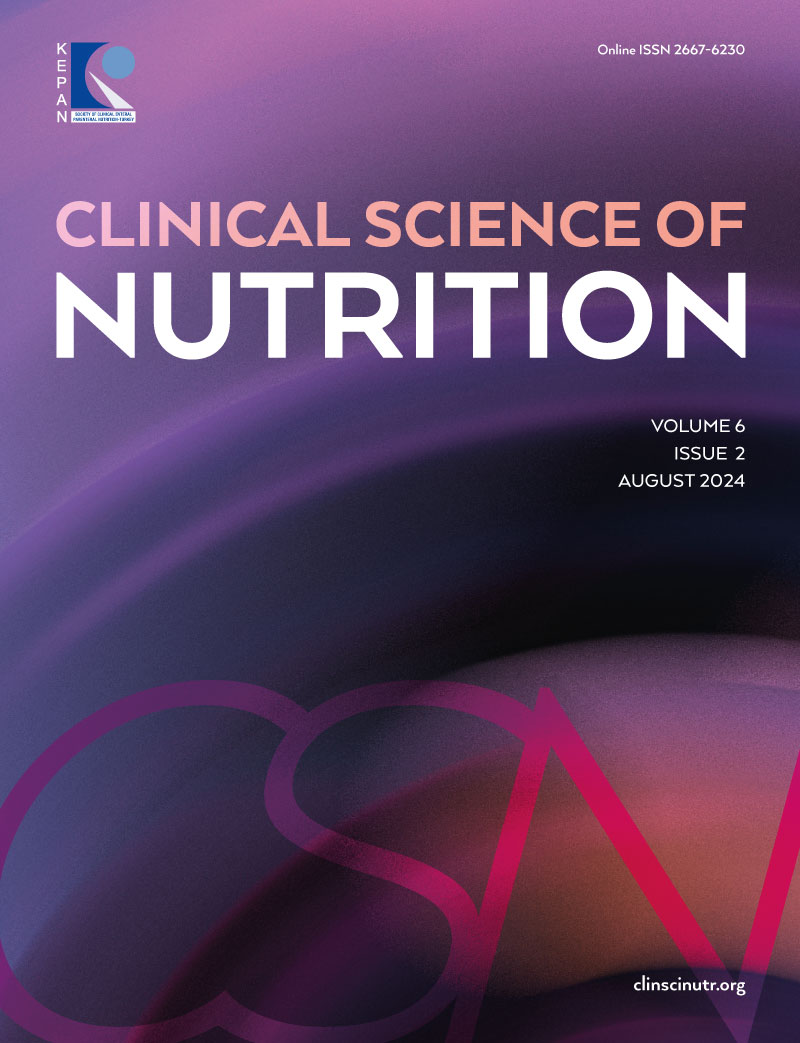Abstract
Objective: Evaluating physicians’ attitudes towards malnutrition and clinical nutrition in hospitalized patients are crucial for the implementation of optimal nutritional care process and the prevent of hospital malnutrition. The aim of this study is to develop a scale that evaluates physicians’ attitudes towards malnutrition in hospitalized patients.
Methods: Based on the existing literature on clinical nutrition and the clinical experience of experts in this field, a 5-point Likert-type attitude scale consisting of 12 items was developed. Analysis was carried out using Parallel Analysis to determine the number of factors in the Exploratory factor analysis based on the Polychoric correlation matrix and Unweighted Least Squares as the factor extraction method.
Results: There are 8 items in the 1st factor (Physician duties) and 4 items in the 2nd factor (Non-Physician duties). The Cronbach Alpha and McDonald’s Omega coefficients of the scale were found to be 0.72 and 0.81 respectively, from the sub-dimensions 0.78 and 0.85 for the 1st Factor, and 0.66 and 0.75 for the 2nd Factor.
Conclusion: Attitude scale for the clinical nutrition care process of hospitalized patients for physicians is an instrument with good psychometric properties that measures examination of physicians’ attitudes related to clinical nutrition care process.
Keywords: attitude scale, clinical nutrition care, physicians
References
- Sauer AC, Goates S, Malone A, et al. Prevalence of malnutrition risk and the impact of nutrition risk on hospital outcomes: Results from nutrition day in the U.S. JPEN J Parenter Enteral Nutr. 2019;43:918-926. https://doi.org/10.1002/jpen.1499
- Lew CCH, Wong GJY, Cheung KP, Chua AP, Chong MFF, Miller M. Association between malnutrition and 28-day mortality and intensive care length-of-stay in the critically ill: A prospective cohort study. Nutrients. 2017;10:10. https://doi.org/10.3390/nu10010010
- Marinho R, Pessoa A, Lopes M, et al. High prevalence of malnutrition in Internal Medicine wards - a multicentre ANUMEDI study. Eur J Intern Med. 2020;76:82-88. https://doi.org/10.1016/j.ejim.2020.02.031
- Lengfelder L, Mahlke S, Moore L, Zhang X, Williams G, Lee J. Prevalence and impact of malnutrition on length of stay, readmission, and discharge destination. JPEN J Parenter Enteral Nutr. 2022;46:1335-1342. https://doi.org/10.1002/jpen.2322
- van Vliet IM, Gomes-Neto AW, de Jong MF, Jager-Wittenaar H, Navis GJ. High prevalence of malnutrition both on hospital admission and predischarge. Nutrition. 2020;77:110814. https://doi.org/10.1016/j.nut.2020.110814
- Bargetzi L, Brack C, Herrmann J, et al. Nutritional support during the hospital stay reduces mortality in patients with different types of cancers: secondary analysis of a prospective randomized trial. Ann Oncol. 2021;32:1025-1033. https://doi.org/10.1016/j.annonc.2021.05.793
- Kaegi-Braun N, Mueller M, Schuetz P, Mueller B, Kutz A. Evaluation of nutritional support and in-hospital mortality in patients with malnutrition. JAMA Netw Open. 2021;4:e2033433. https://doi.org/10.1001/jamanetworkopen.2020.33433
- Correia MIT, Sulo S, Brunton C, et al. Prevalence of malnutrition risk and its association with mortality: nutritionDay Latin America survey results. Clin Nutr. 2021;40:5114-5121. https://doi.org/10.1016/j.clnu.2021.07.023
- Reber E, Strahm R, Bally L, Schuetz P, Stanga Z. Efficacy and efficiency of nutritional support teams. J Clin Med. 2019;8:1281. https://doi.org/10.3390/jcm8091281
- Jensen GL, Compher C, Sullivan DH, Mullin GE. Recognizing malnutrition in adults: definitions and characteristics, screening, assessment, and team approach. JPEN J Parenter Enteral Nutr. 2013;37:802-807. https://doi.org/10.1177/0148607113492338
- Duerksen DR, Keller HH, Vesnaver E, et al. Physicians' perceptions regarding the detection and management of malnutrition in Canadian hospitals: Results of a Canadian Malnutrition Task Force survey. JPEN J Parenter Enteral Nutr. 2015;39:410-417. https://doi.org/10.1177/0148607114534731
- Karim SA, Ibrahim B, Tangiisuran B, Davies JG. What do healthcare providers know about nutrition support? A survey of the knowledge, attitudes, and practice of pharmacists and doctors toward nutrition support in Malaysia. JPEN J Parenter Enteral Nutr. 2015;39:482-488. https://doi.org/10.1177/0148607114525209
- Grammatikopoulou MG, Katsouda A, Lekka K, et al. Is continuing medical education sufficient? Assessing the clinical nutrition knowledge of medical doctors. Nutrition. 2019;57:69-73. https://doi.org/10.1016/j.nut.2018.05.013
- Kirbiyik F, Ozkan E. Knowledge and practices of medical oncologists concerning nutrition therapy: A survey study. Clin Nutr ESPEN. 2018;27:32-37. https://doi.org/10.1016/j.clnesp.2018.07.004
- Han SL, Auer R, Cornuz J, Marques-Vidal P. Clinical nutrition in primary care: An evaluation of resident physicians' attitudes and self-perceived proficiency. Clin Nutr ESPEN. 2016;15:69-74. https://doi.org/10.1016/j.clnesp.2016.06.005
- McGaghie WC, Van Horn L, Fitzgibbon M, et al. Development of a measure of attitude toward nutrition in patient care. Am J Prev Med. 2001;20:15-20. https://doi.org/10.1016/s0749-3797(00)00264-6
- Finney SJ, DiStefano C. Nonnormal and categorical data in structural equation modeling. In: Hancock GR, Mueller RO, editors. Structural equation modeling: A second course. 3rd ed. Charlotte NC: IAP; 2013: 439-492.
- Tabachnick BG, Fidell LS. Using multivariate statistics. 6th ed. Boston: Pearson; 2012.
- Velicer WF, Jackson DN. Component analysis versus common factor analysis: Some issues in selecting an appropriate procedure. Multivariate Behav Res. 1990;25:1-28. https://doi.org/10.1207/s15327906mbr2501_1
- Jung S. Exploratory factor analysis with small sample sizes: A comparison of three approaches. Behav Processes. 2013;97:90-95. https://doi.org/10.1016/j.beproc.2012.11.016
- Kline RB. Principles and practise of structural equating modeling. 3th ed. The Guilford Press; 2011.
- Kılıç AF. Exploratory factor analysis with R software. Anadolu University Journal of Education Faculty. 2020;4:276-293.
- Şencan H, Fidan Y. Normality assumption in the exploratory factor analysis with likert scale data and testing its effect on factor extraction. BMIJ. 2020;8:640-687. https://doi.org/10.15295/bmij.v8i1.1395
- van der Eijk C, Rose J. Risky business: factor analysis of survey data - assessing the probability of incorrect dimensionalisation. PLoS One. 2015;10:e0118900. https://doi.org/10.1371/journal.pone.0118900
- Kalaycı Ş. Faktör analizi. In: Kalaycı Ş, editor. SPSS uygulamalı çok değişkenli istatistik teknikleri. Ankara: Asil Yayın Dağıtım; 2014: 321-331.
- Lloret S, Ferreres A, Hernández A, et al. The exploratory factor analysis of items: Guided analysis based on empirical data and software. Anales de Psicología. 2017;33(2):417-432. https://doi.org/10.6018/analesps.33.2.270211
- Bryman A, Cramer D. Quantitative data analysis with SPSS release 8 for Windows. Routledge: Taylor and Francis e-Librar; 1999.
- Kline P. An easy guide to factor analysis. London: Routledge; 1994.
- Çokluk Ö, Şekercioğlu G, Büyüköztürk Ş. Sosyal bilimler için çok değişkenli istatistik. Ankara: Pegem Akademi Yayınları; 2010.
- Revelle WR. psych: Procedures for Personality and Psychological Research 2017.
- Kelley TL. Essential traits of mental life, Harvard studies in education. Cambridge: Harvard University Press; 1935.
- Schermelleh-Engel K, Moosbrugger H, Müller H. Evaluating the fit of structural equation models: Tests of significance and descriptive goodness-of-fit measures. Methods of Psychological Research Online. 2003;8(2):23-74.
- Yu C, Muthen B. Evaluation of model fit indices for latent variable models with categorical and continuous outcomes. In: Annual Meeting of the American Educational Research Association. New Orleans, LA; 2002.
Copyright and license
Copyright © 2024 The author(s). This is an open-access article under the terms of the Creative Commons Attribution License (CC BY) which permits unrestricted use, distribution, and reproduction in any medium or format, provided the original work is properly cited.










